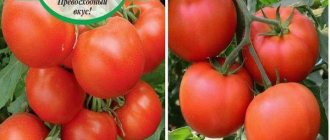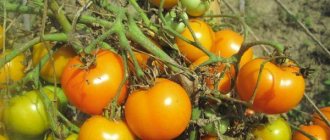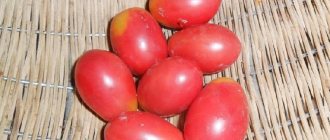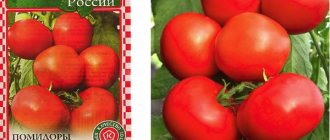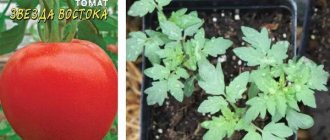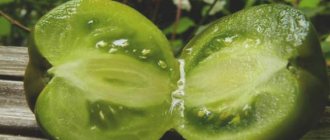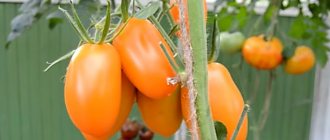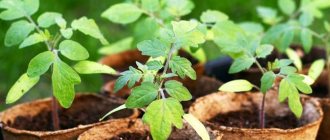Tomato Lord of the Steppes, according to reviews, shows high productivity and some consider it the first in this indicator. The plant belongs to the category of mid-season hybrids of a determinate species. Initially, the variety was bred for cultivation in the southern regions of the country in open ground conditions. Today the variety is included in the State Register of the North Caucasus region. In the northern regions, a high-yielding plant is grown under film.
Low-growing bushes reach a height of 55 to 60 cm. The plant has a good ability to set fruit. The leaves have the usual tomato shape and characteristic green color.
Reviews about the Lord of the Steppes confirm the excellent taste and aesthetic qualities of the hybrid. Description of fruits:
- characteristic round shape;
- smooth to the touch surface;
- rich classic red color when ripe;
- medium density of pulp with good juiciness and proper taste.
Yield characteristics:
- average weight is considered to be from 80 to 185 grams;
- individual fruits gain weight up to 500 grams;
- With proper care, up to 6.5 kg of tomatoes can be harvested from 1 m2.
In a greenhouse, such bunches of tomatoes look very impressive, and the yield of marketable fruits ranges from 68 to 98%. The fruits are used for fresh eating and as a material for canning.
Tomatoes of this variety are ideal for making pickles for the winter. The smooth, rounded fruits fit tightly together in the jar and look very appetizing.
Description and characteristics of the variety
Lord of the Steppes F1 is a low-growing determinate hybrid. The height of the bushes does not exceed 50 cm. The shoots, despite their low growth, are powerful and spreading. They require garters and shaping.
Ripening time is average - 110-115 days from germination.
Tomatoes have a round shape and a rich red color. The taste harmoniously combines sourness and sweetness. Tomatoes are used universally:
- for fresh salads;
- whole into canning jars;
- for pickling and drying;
- in juices and pastes.
The average weight varies between 80-130 g, large specimens grow up to 160 g.
Rules for growing the variety
It is advisable to prepare seed material in a timely manner. Cultivation occurs by planting seeds in the ground. Planting seed material into the ground is recommended 60-65 days in advance. Picking is carried out when 1-2 true leaves appear, and this procedure increases the chances of obtaining the desired harvest and eliminating the risk of excessive development of green mass.
When transplanting seedlings, up to 5 plants are allowed per square meter. This is due to the small size of tomato bushes.
Note! The Lord of the Steppes variety does not need to be tied up, but the presence of support will not interfere with the plant. Tying is no longer necessary, since tomato bushes are low-growing. Tying is advisable, as sometimes large fruits grow.
Stepping is mandatory. The best harvest can be obtained when 2 main stems are formed. For the Lord of the Steppes variety, it is recommended to leave no more than 4 stems. It is important to note that the second stem is always formed from the stepson, which is located under the first brush. All other stepsons require timely removal to obtain a good harvest, and they need to be removed in a small amount to prevent stress in the tomatoes.
The first ripe tomatoes can be harvested approximately 105 days after the plant was planted in the ground.
Regular watering and loosening of the soil are mandatory for the Lord of the Steppes variety. They increase the chances of receiving the right amount of water and oxygen, so the tomatoes develop successfully.
During the season, it is advisable to carry out 3 feedings. In this case, the first application of fertilizers is recommended during the growing season, the second - when inflorescences appear, the third - at any time when growing tomatoes to improve the yield.
No special care required. Gardeners note that the Lord of the Steppes tomato variety requires standard agricultural technology.
Kalroma F1
Early ripening determinate hybrid of tomato. In the middle zone it is suitable for growing in greenhouses and open ground. The ripening period is about 90-100 days. Sowing for seedlings - March. Picking seedlings - in the phase of the first true leaf. Planting in the ground - in early to mid-May at the age of 45 days. Planting pattern – 40×60 cm.
The fruits are elongated, weighing 80-85 g, universal purpose. The yield is 4.5-5 kg per bush. The plant is resistant to fusarium, verticillium, bacterial spot and nematode. Withstands sudden temperature changes.
Portland F1
Mid-early determinate tomato hybrid. In the middle zone it is suitable for growing in film and glass greenhouses. The ripening period is about 108-110 days. Sowing for seedlings - late March - early April. Picking seedlings - in the phase of the first true leaf. Planting in closed ground - in early to mid-May at the age of 40 days. Planting pattern – 40×60 cm.
The fruits are flat-round, weighing 110-130 g, universal purpose. The yield is 5-5.2 kg per bush. The plant is resistant to the pathogens of tobacco mosaic virus, cladosporiosis, and fusarium.
You need to choose tomatoes for growing in your region wisely - only in this case can you count on a good harvest. We have also already written about how to solve this problem.
- Varieties or hybrids - which is right for you, and how to choose tomato seeds for your region
When choosing tomato seeds, the main thing is to focus not on the beautiful picture on the package, but on the conditions of your garden, the characteristics of the plants, and the purpose of the fruit.
Reviews
Vlada:
“I’ve been gardening for several years now. During this time, I tried different varieties of tomatoes. Last summer I grew Lord of the Steppes. Easy standard care allowed me to get a rich and very tasty harvest, so I immediately ranked the variety among my favorites. I also plan to plant Lord of the Steppes in the upcoming gardening season.”
Antonina:
“Vegetable gardening is my hobby. I love growing tasty and healthy vegetables, knowing that my efforts and time investment are completely worth it. The Lord of the Steppes variety of tomatoes is considered one of the best and tastiest, so I mainly choose it.”
Oksana:
“The Lord of the Steppes is a very famous and worthy variety of tomatoes. These are the tomatoes that can please beginners and experienced gardeners. In addition, agricultural technology is carried out according to a standard scheme and requires a minimum of time for gardeners.”
Paul Robson tomato
Opinions about it are as contradictory as the color of its sides - from red to dark brown, almost black.
It can be recognized by its chocolate-brown skin with a glossy gloss, with a green spot near the fruit - the vine-shaped tomato Paul Robeson is known to many connoisseurs of tomato growers.
What beginners don’t know, what is worth knowing about chokeberry - detailed characteristics, disadvantages and advantages, subtleties of cultivation.
About the black chokeberry variety, opinions about which vary greatly. What did not please gardeners, what pleased them.
Seed material is distributed by the Biotechnika agro-group, St. Petersburg. Known in the European Union and the USA as the Paul Robeson variety. At Caramel TomatoFest, an international tasting exhibition, it was recognized as the best in terms of taste and aroma.
Description, characteristics
Russian selection, distributed by the Biotechnika agro-group, St. Petersburg (the selection is indicated as amateur). It is grown in open and closed ground, good for hotbeds and hothouses, and feels at ease in country garden beds.
In the photo there is a Paul Robeson tomato, a small specimen - the color is not conveyed quite correctly, in real life it is browner
Medium ripening period, sometimes referred to as mid-late.
- The growing season is 115-120 days. Salad type, used fresh in cooking.
- Indeterminate (semi-indeterminate) type - self-limiting in growth after the 7th hand, requires gartering and pinching. The bush is tall, medium spreading, medium leafy.
- The leaves are dark green, medium. The fruits are flat-rounded, somewhat ribbed at the stalk, collected in clusters of 4-5 pieces. Fruit weight ranges from 70-100 g to 250-300 g - depending on the method of formation, soil fertility, and fertilizing. The shape is round, the largest specimens are slightly ribbed, the small ones are smooth and even.
- As it ripens, the skin changes color from green to brown-red, red-brown, with a chocolate tint, and the spot on the fruit stem becomes colored. The peel is thin, but strong, preventing neat, dense tomatoes from cracking. The taste is rich, pleasant, multifaceted. The pulp is fleshy, low-seeded, sugary at the break.
- The weight for aronia is decent - up to 400 g. More suitable for indoor ground, but not bad in open ground. Used fresh, for processing - for sauces, ketchups and other tomatoes.
- Those collected at technical and full maturity are well stored and can withstand transportation. When collected in incomplete ripeness, they ripen at room temperature.
It is famous for its high content of lycopene and sugars, due to which it is considered very useful. According to reviews, it is suitable for those who cannot tolerate red fruits.
Growing and care
A few words about growing the Paul Robson tomato variety - let's start from the beginning: briefly and abstractly - from sowing seeds to formation.
It is advisable to sow the seeds in the second half of March, soaking them in a proven growth stimulant to speed them up. The soil mixture should be light and not contain a potential pathogenic environment.
The substrate can also be lightened with a handful of river sand or enriched with wood ash. The optimal germination temperature is +23…+25 C. After germination, the seedlings are placed under additional lighting lamps in simply well-lit places.
They are picked at the stage of the first true leaves, after which they are fed with full mineral fertilizer.
Paul Robeson tomatoes are planted in open ground starting in the third ten days of May or a little earlier in the south. In greenhouses with earlier sowing of seeds - at any convenient time
Important - does not like acidic soils - will respond with a change in taste, low productivity
Planting density is average: the planting pattern is traditional - no more than 3 bushes per m2.
The formation of the Paul Robeson variety is carried out in two stems, less often in one, leaving 4-5 clusters. It is advisable to carry out careful picking. Standardization is also carried out to increase the size and prevent chopping - the flowers are removed, leaving no more than 3-4 in the brush.
It is advisable to thin out or break off the leaves of the lower tiers - just not all at once, several at a time every 5-7 days: this will switch the nutrition to a direction that is more promising for the gardener - to fruits. In addition, lodging, collecting dew, breeding dampness after watering is the best breeding ground for late blight.
Fertilizing is traditional: pre-planting soil filling with humus, potassium sulfate, superphosphate.
During flowering, it is advisable to apply complete mineral fertilizers with a sufficient content of potassium, calcium, trace elements of iron, phosphorus, etc.
, during fruit formation - magnesium sulfate, a full complex of microelements. In the second half of the growing season, nitrogen should not dominate: we grow tops, not tomatoes.
Advantages and disadvantages
The plant tolerates heat and drought well. The variety tolerates temperature changes well. It does not have good resistance to various tomato diseases, so it is rated as average.
The advantage of this variety is its excellent combination of large fruit and yield. For a month, the fruit is able to maintain good taste and tolerates transportation well.
See also
Description of the tomato variety Cherryfingers and its characteristicsRead
Aramis F1
Mid-season indeterminate tomato hybrid, needs garter. In the middle zone it is suitable for growing in film and winter greenhouses. Ripening period – 110 days. Sowing for seedlings - March. Picking seedlings - in the phase of the first true leaf. Planting in closed ground - in early to mid-May at the age of 45 days. Planting pattern – 40×60 cm.
The fruits are round, slightly elongated, weighing about 130 g, and have a universal purpose. The yield is 3-4.5 kg per bush. The plant is resistant to tobacco mosaic virus, fusarium and cladosporiosis. It has the ability to set fruit even with sudden temperature changes.
Pests and diseases
The hybrid bushes are characterized by increased resistance to Fusarium lesions and Verticillium wilt. Possible diseases of mosaic viruses, which appear as brown spots on the leaves, stems and tomatoes themselves, are also not dangerous for tomatoes.
You may be interested in: Dates for planting tomato seedlings in open ground and greenhouses according to the garden calendar Favorable days for planting tomatoes for seedlings in 2021 according to the lunar sowing calendar Favorable days for picking tomatoes in 2021 after germination: timing of picking tomato seedlings in the table by day
As a preventive protection against tobacco mosaic, spider mites and blossom end rot, which appear as brown spots, it is recommended to use a two-day infusion of garlic mixture. For this you need 250 - 300 g of pressed garlic and 8 - 9 liters of water. The first spraying should be carried out no earlier than two weeks after planting the seedlings, so that the root system has time to strengthen. Repeated treatment is carried out after a week's break.
Premature yellowing and curling of leaves on tomato bushes may indicate a lack of copper in the nutrient complex. It can be replenished by adding mineral complexes to the water, which is then used to water the tomatoes.
If fungicides are used to treat bushes against insect pests, it is better to spray in the late evening so that the substance has time to be absorbed into the leaves and not just evaporate. The work itself must be carried out no later than 2.5 - 3 weeks before the planned harvest.
Nerd F1
Mid-early indeterminate tomato hybrid, needs garter. In the middle zone it is suitable for growing in greenhouses. Ripening period is 100-105 days. Sowing for seedlings - March. Picking seedlings - in the phase of the first true leaf. Planting in closed ground - in early to mid-May at the age of 45 days. Planting pattern – 40×60 cm.
The fruits are round in shape, weighing about 100-150 g, and have a universal purpose. The yield is 4-4.5 kg per bush. The plant is resistant to tobacco mosaic virus, fusarium and cladosporiosis, as well as blossom end rot and fruit cracking.
